Top Tips for Eco-Friendly Fast Food Packaging
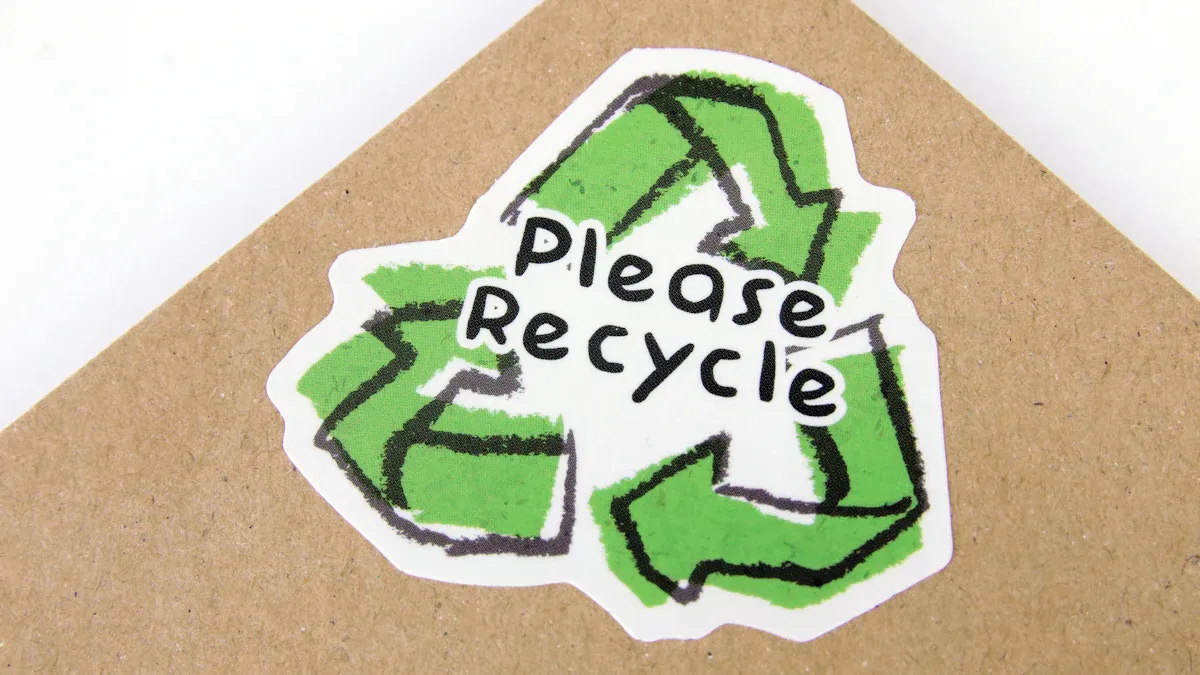
Image Source: unsplash
Fast food packaging creates a huge problem for the environment. Think about all the wrappers, boxes, and cups tossed out every day. Most of it ends up in landfills, taking years to break down, or worse, polluting oceans and harming wildlife. Switching to eco-friendly options can make a big difference. It helps reduce waste, protects nature, and even boosts a business's reputation. Plus, as a customer, it feels good to know your meal didn’t hurt the planet. Isn’t it time we all made smarter choices?
Key Takeaways
-
Eco-friendly packaging cuts waste and helps the planet. Using biodegradable or recyclable materials lowers pollution and protects animals.
-
Green packaging improves how people see your business. Customers like brands that care about the Earth and may pay extra for eco-friendly choices.
-
Working with green suppliers makes things run better. These suppliers can save money, improve quality, and deliver faster, helping your business succeed.
-
Teaching workers and customers about being green builds awareness. Training and clear messages can create a group that cares about the environment.
-
Checking your eco-friendly efforts often shows progress. These checks find ways to get better and keep your business focused on helping the planet.
Why Eco-Friendly Fast Food Packaging Matters
Environmental Challenges of Traditional Packaging
Traditional fast food packaging has a massive environmental footprint. Most of it is made from single-use plastics or Styrofoam, which take hundreds of years to decompose. This waste often ends up in landfills or oceans, harming wildlife and polluting ecosystems. Did you know that in 2018 alone, over 82 million tons of packaging waste were generated in the U.S.? Of that, only about 44 million tons were recycled, leaving a significant amount to be landfilled or incinerated.
|
Management Pathway |
1960 |
1980 |
2000 |
2018 |
|---|---|---|---|---|
|
Generated (in tons) |
27,370 |
52,670 |
75,840 |
82,220 |
|
Recycled (in tons) |
2,870 |
8,490 |
28,870 |
44,330 |
|
Landfilled (in tons) |
24,500 |
43,300 |
37,860 |
30,470 |
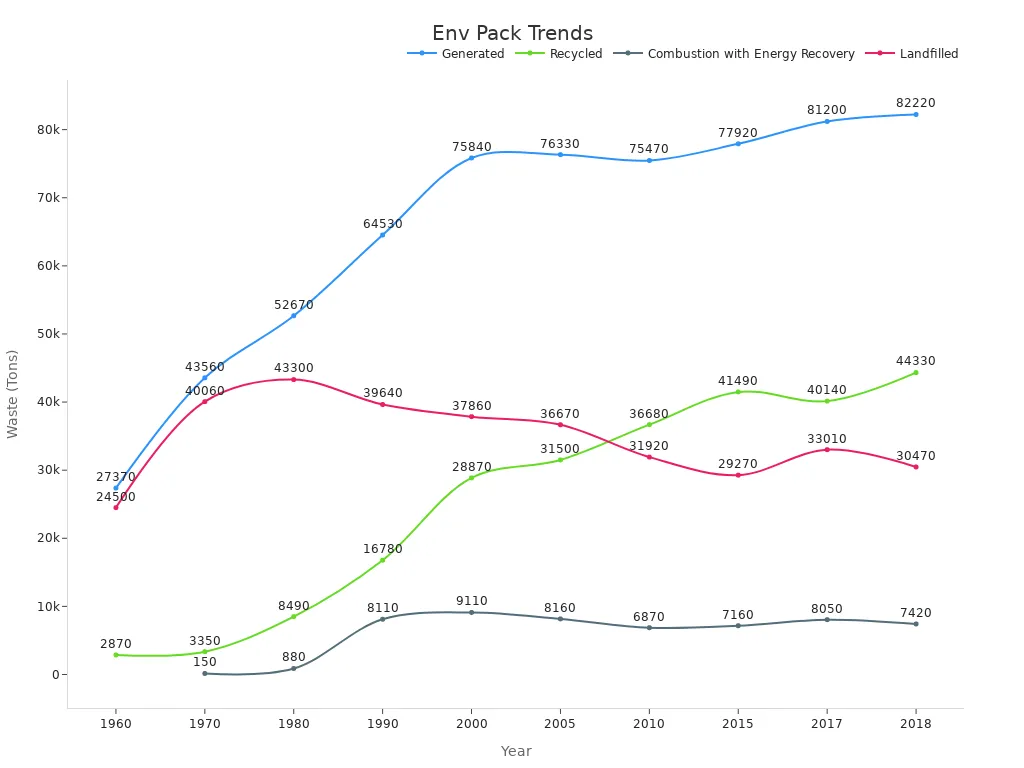
Switching to eco-friendly fast food packaging can help reduce this burden. By choosing materials that are biodegradable or recyclable, you can play a role in protecting the planet.
Advantages of Sustainable Packaging for Businesses
Eco-friendly packaging isn’t just good for the environment—it’s great for business too. Many companies, like Coca-Cola, have seen benefits from adopting sustainable practices. They’ve saved money by reducing packaging size and weight, which lowers shipping costs. Plus, using recyclable materials can cut down on raw material expenses.
But the biggest win? Customers love it. Studies show that people are more likely to support brands that invest in green initiatives. In fact, many consumers are even willing to pay more for products with sustainable packaging. By going green, you can boost your brand’s reputation and build loyalty among eco-conscious customers.
Meeting Consumer Expectations for Green Practices
Today’s consumers expect more from businesses. They want to see real efforts toward sustainability, especially in industries like fast food. Research shows that 50% of people are willing to pay a premium for sustainable food packaging. For fresh fruits, vegetables, and even meat, nearly half of consumers are happy to pay 1-3% more if the packaging is eco-friendly.
|
Statistic |
Percentage of Consumers |
|---|---|
|
Willing to pay a premium for sustainable food packaging |
50% |
|
Willing to pay 1-3% more for sustainably packaged fresh fruits and vegetables |
47% |
|
Willing to pay 1-3% more for sustainably packaged fresh meat, poultry, and fish |
49% |
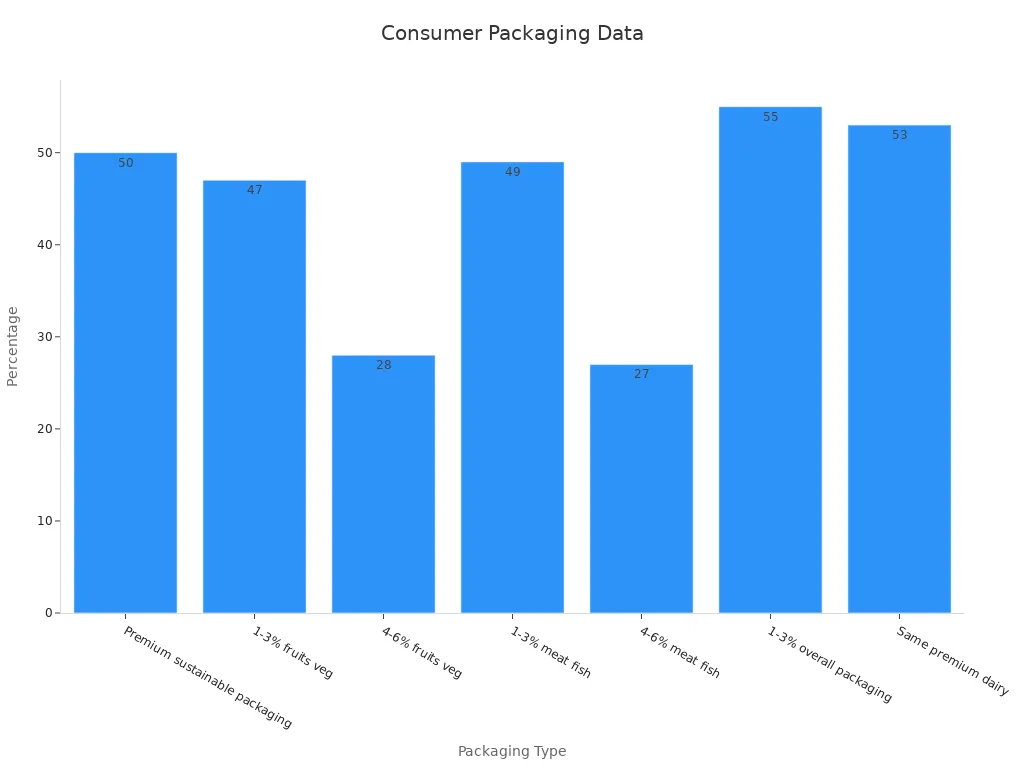
By adopting eco-friendly fast food packaging, you’re not just meeting these expectations—you’re staying ahead of the curve. Customers notice when businesses care about the planet, and they’ll reward you with their loyalty.
Best Eco-Friendly Packaging Materials
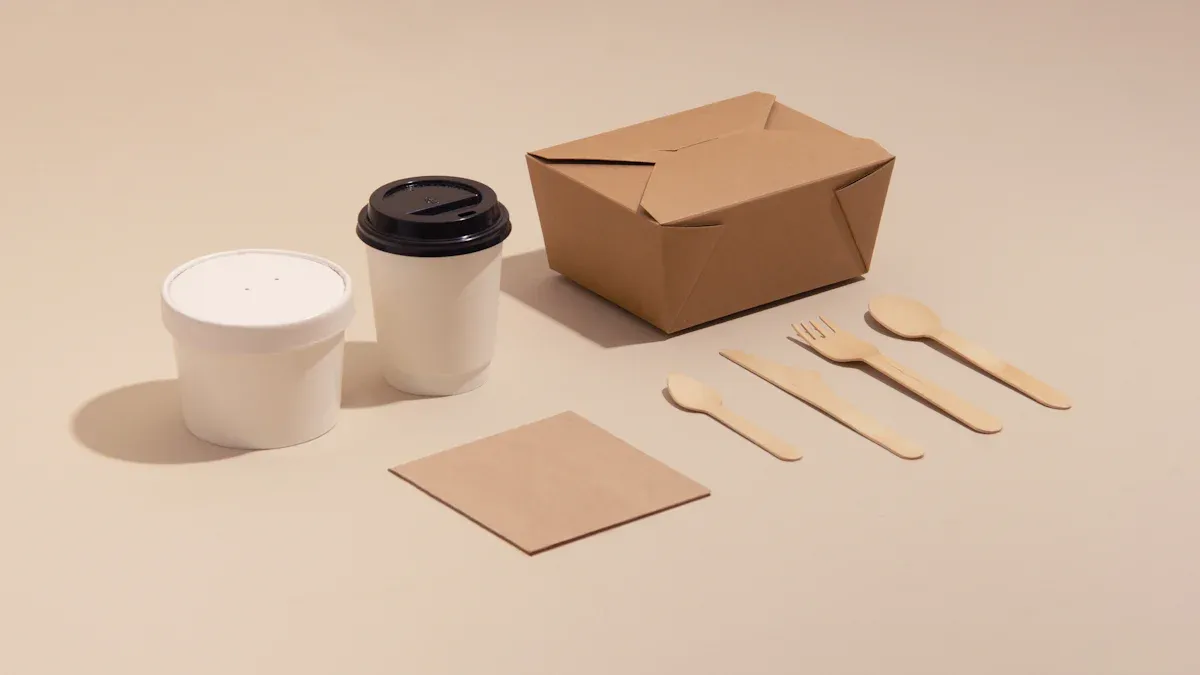
When it comes to fast food packaging, choosing the right materials can make a big difference for the planet. Let’s explore some of the best eco-friendly options available today.
Compostable and Biodegradable Options
Compostable and biodegradable packaging is a game-changer for reducing waste. These materials break down naturally, leaving no harmful residue behind. For example, biopolymers and plant-based fibers are leading the way in creating sustainable alternatives to traditional plastics. Many of these materials meet strict certifications like ASTM D6400-04 and ISO 17088, ensuring they decompose efficiently and safely.
Here’s what makes them stand out:
-
Biodegradation: At least 90% of the material decomposes within 180 days.
-
Composting: After composting, 90% of the material passes through a 2 mm sieve.
-
Safety: Heavy metal content stays below harmful levels, protecting soil and plants.
These options not only help the environment but also align with consumer expectations for greener practices. Imagine offering packaging that doesn’t just hold food but also nurtures the earth—it’s a win-win!
Recycled and Recyclable Paper Products
Paper-based packaging is another excellent choice for eco-friendly fast food packaging. Recycled paper products reduce waste and energy use during production, making them a sustainable alternative to virgin materials. A study comparing duplex board (93% recycled fiber) with folding boxboard (100% virgin fiber) found that recycled paper is better for the environment across all impact categories, including global warming potential.
|
Aspect |
Details |
|---|---|
|
Material Evolution |
Paper alternatives are gaining traction due to recyclability and durability. |
|
Performance Enhancements |
Innovations in active packaging improve durability and usability. |
|
Sustainability Focus |
Recycled paper aligns with the 3R principles: Reduce, Reuse, Recycle. |
While paper packaging is recyclable and biodegradable, it does have a resource-intensive production process. However, advancements in energy efficiency are helping to address this challenge. By choosing recycled paper products, you’re not just reducing waste—you’re actively contributing to a cleaner future.
Plant-Based Plastics and Bioplastics
Plant-based plastics and bioplastics are revolutionizing the packaging industry. These materials are made from renewable resources like corn starch or sugarcane, offering a reduced carbon footprint compared to petroleum-based plastics. Governments and industries are increasingly supporting bioplastics to meet consumer demand for sustainable options.
Here’s why they’re gaining popularity:
-
Eco-Friendly Manufacturing: Improved processes make bioplastics more appealing and cost-effective.
-
Regulatory Support: Policies promote the use of sustainable materials, driving innovation.
-
Collaboration: Partnerships among governments, industries, and NGOs foster sustainable supply chains.
Bioplastics are not only better for the environment but also offer the durability and versatility needed for fast food packaging. As technology advances, these materials are becoming more accessible and affordable, making them a smart choice for businesses looking to go green.
Innovative Edible Packaging Solutions
Imagine eating your burger and then munching on the wrapper—it sounds futuristic, but edible packaging is already making waves in the food industry. This innovative solution not only reduces waste but also offers a unique way to enjoy your meal while protecting the planet.
Edible packaging is made from natural ingredients like seaweed, rice, and even mushrooms. These materials decompose naturally, unlike plastic, which can linger in landfills and oceans for centuries. Here’s why edible packaging is gaining traction:
-
It significantly reduces non-biodegradable waste, helping to alleviate waste management issues.
-
Seaweed-based packaging degrades quickly in water, cutting down on plastic pollution in marine environments.
-
Mycelium-based materials, derived from fungi, are strong, scalable, and promote a circular economy.
Tip: If you’re a fast food business, edible packaging could be your next big move. It’s not just eco-friendly—it’s a conversation starter that customers will love.
Emerging research shows that edible packaging has the potential to transform the fast food packaging industry. Scientists are improving the safety and scalability of materials like mycelium, making them more practical for everyday use. Regulatory frameworks are also adapting to support these new technologies, paving the way for widespread adoption.
Seaweed-based packaging is particularly exciting. It’s not only sustainable but also versatile. You can use it for wraps, cups, or even condiment sachets. Plus, it poses less risk to ecosystems, making it a win-win for businesses and the environment.
Edible packaging isn’t just about reducing waste—it’s about rethinking how we interact with food. By choosing edible options, you’re not just serving meals; you’re serving solutions to some of the planet’s biggest problems.
Packaging Practices to Avoid
Single-Use Plastics and Styrofoam
Single-use plastics and Styrofoam are some of the worst offenders when it comes to environmental harm. These materials are lightweight, cheap, and convenient, but they come at a heavy cost to the planet. Plastic bags, Styrofoam containers, and other single-use items often end up in landfills or waterways, polluting ecosystems and harming wildlife.
-
In 2018, the U.S. generated 35.7 million tons of plastic waste, but only 8.7% of it was recycled.
-
Landfills received 27 million tons of plastic waste that year, making up 18.5% of all municipal solid waste.
-
The production of plastics also releases greenhouse gases, contributing to climate change.
By avoiding single-use plastics and Styrofoam, you can help reduce pollution and protect the environment. Switching to reusable or biodegradable alternatives is a small step that makes a big difference.
Excessive Packaging Waste
Have you ever opened a small item only to find it wrapped in layers of unnecessary packaging? This practice creates excessive waste that often ends up in landfills. In 2018, over 82 million tons of packaging waste were discarded in the U.S., with 37% of it ending up in landfills.
-
Recycling rates have improved, but many packaging materials remain non-recyclable.
-
Landfills emit harmful gases like methane, which contribute to global warming.
-
Toxic leachate from landfills can contaminate nearby water sources, harming ecosystems.
Reducing packaging waste starts with smarter design. Businesses can use minimal, recyclable materials to cut down on waste and lower their environmental impact.
Non-Recyclable Materials
Non-recyclable materials are a major roadblock to sustainability. Plastics that can’t be recycled often accumulate in ecosystems, causing long-term damage.
|
Problem |
Impact |
|---|---|
|
Non-recyclable plastics |
Contribute to waste buildup in ecosystems |
|
Poor design |
Prevents 30% of plastic waste from being recycled |
|
Low recycling rates |
Only 9% of plastic waste is recycled globally |
Switching to recyclable or compostable materials can help solve this issue. By choosing better materials, you’re not just reducing waste—you’re helping create a cleaner, greener future.
Practical Tips for Fast Food Businesses
Partnering with Eco-Friendly Suppliers
Choosing the right suppliers can make or break your sustainability efforts. By partnering with eco-friendly suppliers, you gain access to materials that are better for the planet and your bottom line. Suppliers offering biodegradable, compostable, or recyclable options help you reduce waste while meeting customer expectations for green practices.
The benefits go beyond just the environment. Studies show that businesses working with sustainable suppliers experience improvements in cost, quality, and delivery performance. Take a look at the metrics:
|
Metric |
Beta (B) |
T-value |
P-value |
|---|---|---|---|
|
Cost Performance |
0.74 |
7.569 |
0.000 |
|
Quality Performance |
0.71 |
7.697 |
0.000 |
|
Delivery Performance |
0.65 |
3.717 |
0.000 |
These numbers highlight how eco-friendly partnerships can boost efficiency and profitability. Plus, they help you stay ahead of regulations on single-use plastics, positioning your business as a leader in environmental compliance.
Tip: When choosing suppliers, ask about their certifications and track record in sustainability. This ensures you’re working with partners who align with your green goals.
Implementing Reusable Packaging Systems
Reusable packaging systems are a game-changer for fast food businesses. They reduce waste, save money, and promote a circular economy. Instead of tossing out single-use containers, reusable options can be cleaned and used again, cutting down on the environmental impact of your supply chain.
This approach doesn’t just benefit the planet—it’s great for your business too. Reusable packaging has a long lifespan, which means fewer purchases over time. It also appeals to eco-conscious customers who value sustainability. Imagine offering a reusable cup or container that customers can bring back for a discount—it’s a win-win!
Research shows that transitioning to reusable systems leads to significant cost savings while minimizing waste. It’s a practical step that aligns with modern sustainability goals.
Note: Start small by introducing reusable options for high-volume items like drink cups or food containers. Gradually expand as you see customer adoption grow.
Educating Staff and Customers on Sustainability
Sustainability isn’t just about the materials you use—it’s about the mindset you create. Educating your staff and customers on eco-friendly practices can amplify your efforts and build a community of environmentally conscious individuals.
For your team, training sessions on proper waste disposal and the benefits of sustainable packaging can make a big difference. When employees understand the “why” behind your green initiatives, they’re more likely to support and promote them.
For customers, clear communication is key. Use signage, social media, and packaging labels to explain how your fast food packaging choices help the planet. Highlight the importance of recycling and proper disposal. Case studies show that businesses adopting plant-based containers saw increased customer loyalty because patrons appreciated their commitment to sustainability.
Tip: Create a rewards program for customers who bring back reusable packaging or actively participate in recycling efforts. It’s a great way to encourage green habits while boosting engagement.
Conducting Regular Sustainability Assessments
If you want to make a real impact with your eco-friendly packaging efforts, regular sustainability assessments are a must. These assessments help you figure out what’s working and what’s not. They give you a clear picture of how your fast food business is performing in terms of waste reduction and environmental impact. Think of it as a health check-up for your sustainability goals.
Why are these assessments so important? For starters, they help you measure waste. You can identify areas where you’re falling short, like overproduction or expired products. Once you know the problem, you can take steps to fix it. For example:
-
You might discover that too much food is being thrown away because of poor inventory management.
-
Or maybe your packaging isn’t being recycled as much as you thought.
By pinpointing these issues, you can create strategies to improve eco-efficiency and reduce waste.
Tip: Use these assessments to track your progress over time. It’s a great way to see how small changes add up to big results.
Another benefit of sustainability assessments is that they highlight areas where you can do better. Studies show that many fast food businesses don’t meet sustainability standards. This isn’t because they don’t care—it’s often because they don’t know where they’re falling short. Regular reviews can shine a light on these gaps, giving you the chance to make meaningful improvements.
Here’s how you can get started:
-
Set clear goals: Decide what you want to achieve, like reducing packaging waste by 20% or switching to 100% recyclable materials.
-
Track your data: Keep records of how much waste you generate and how much of it gets recycled or composted.
-
Analyze the results: Look for patterns or problem areas. Are certain locations generating more waste? Are some materials harder to recycle?
-
Take action: Use what you’ve learned to make changes. This could mean training staff, switching suppliers, or redesigning your packaging.
Note: Don’t forget to share your progress with your customers. People love to see businesses taking steps to protect the planet. It builds trust and loyalty.
Sustainability assessments aren’t just about finding problems—they’re about creating solutions. They help you stay on track and show your commitment to going green. Plus, they’re a great way to stand out in a competitive market. When you take the time to assess and improve, you’re not just helping the environment. You’re building a stronger, more sustainable business. 🌱
The Role of Consumers in Sustainable Fast Food Packaging
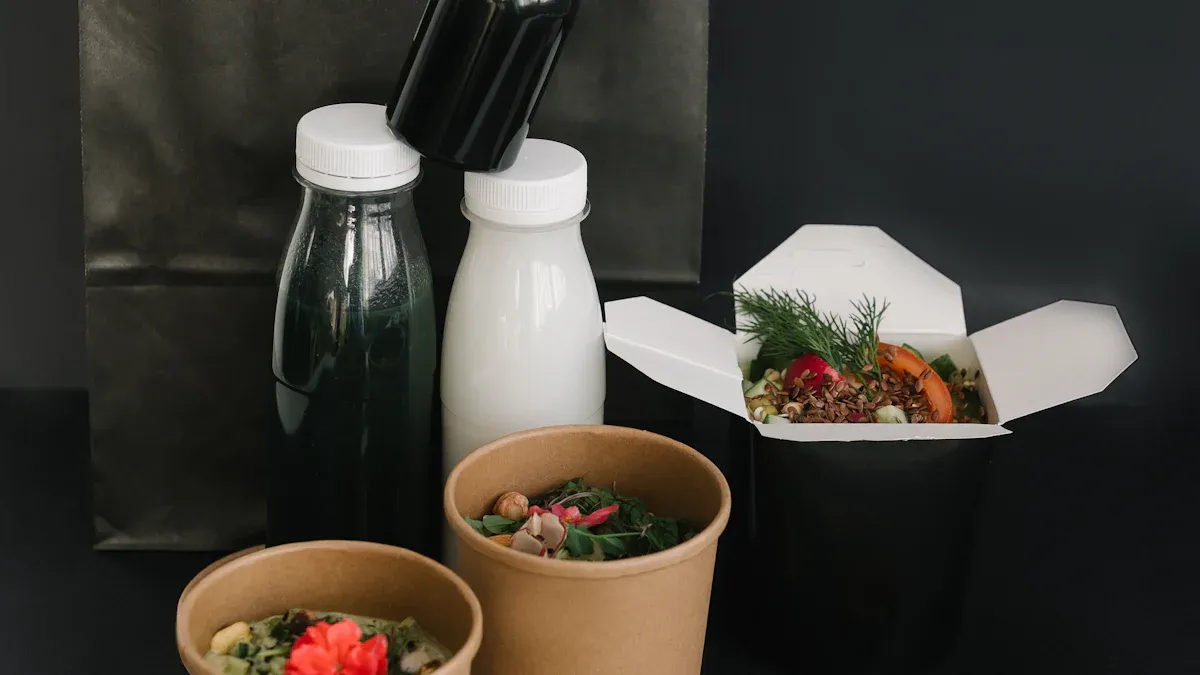
Supporting Restaurants with Green Initiatives
You have more power than you think when it comes to encouraging sustainable practices. By choosing to dine at restaurants that prioritize eco-friendly fast food packaging, you send a clear message: sustainability matters. Studies show that consumers are willing to pay more for eco-friendly options, and this willingness directly influences restaurants to adopt greener practices.
-
Restaurants with strong environmental initiatives often see increased customer loyalty.
-
Positive consumer attitudes toward green practices lead to higher intentions to visit these establishments.
-
Many people are happy to pay a premium for sustainable packaging, knowing it supports environmental well-being.
When you support businesses that care about the planet, you’re not just buying a meal—you’re investing in a better future.
Tip: Look for restaurants that use compostable, recyclable, or reusable packaging. Your choice can inspire others to follow suit.
Advocating for Eco-Friendly Packaging
Your voice matters. Advocacy plays a huge role in pushing businesses to adopt sustainable packaging solutions. Sharing your thoughts with restaurant owners or leaving feedback on social media can make a difference. Research shows that consumer awareness and demand significantly influence how businesses approach packaging.
|
Study Title |
Findings |
|---|---|
|
Sustainable Paper-Based Packaging: A Consumer’s Perspective |
Sustainability cues on packaging positively influenced consumer evaluations. |
|
Impact of Green Packaging |
Social influence and perceived consumer effectiveness drive green consumption behavior. |
You can also join community initiatives or campaigns that promote eco-friendly packaging. The more people advocate for change, the faster businesses will adapt.
Note: Even small actions, like signing petitions or participating in local clean-up drives, can amplify your impact.
Proper Disposal and Recycling of Packaging
Recycling isn’t just about tossing items into the right bin—it’s about understanding what can and cannot be recycled. Fast food packaging often ends up in landfills because of improper disposal. Did you know that packaging waste accounts for 28.1% of municipal trash? That’s nearly 82 million tons annually!
Here’s how you can help:
-
Check for recycling symbols on packaging before disposal.
-
Rinse food containers to avoid contamination in recycling bins.
-
Separate compostable items from recyclable ones.
Did you know? Nearly 71% of shoppers now choose products with sustainable packaging. By recycling properly, you contribute to this growing trend and reduce landfill waste.
Your efforts might seem small, but they add up. Proper disposal ensures that recyclable materials get a second life, reducing the need for new resources.
Switching to eco-friendly fast food packaging is more than just a trend—it’s a necessity for a sustainable future. It protects the environment, saves money, and builds stronger connections with customers. Take a look at the benefits:
|
Benefit Type |
Description |
|---|---|
|
Environmental Benefits |
Reduces waste of resources, minimizes resource depletion, and lessens pollution. |
|
Economic Impact |
Lowers material usage and waste management costs, leading to savings on shipping and improved profits. |
|
Brand Image |
Enhances brand reputation by demonstrating environmental responsibility, leading to increased sales. |
|
Customer Satisfaction |
Meets customer expectations for sustainability, resulting in repeat business and loyalty. |
|
Social Benefits |
Promotes social responsibility, leading to positive brand recognition and employee satisfaction. |
You can make a difference by choosing sustainable materials, reducing waste, and supporting eco-conscious brands. Every small step counts toward a greener planet. 🌍
FAQ
What makes packaging “eco-friendly”?
Eco-friendly packaging uses materials that are biodegradable, compostable, or recyclable. It minimizes harm to the environment by reducing waste and conserving resources. Look for certifications like FSC (Forest Stewardship Council) or labels that indicate recyclability. 🌱
Are biodegradable and compostable packaging the same?
Not exactly! Biodegradable packaging breaks down naturally over time, but compostable packaging decomposes into nutrient-rich soil under specific conditions. Compostable options are often better for the environment since they leave no toxic residue.
How can I tell if packaging is recyclable?
Check for recycling symbols on the packaging. Numbers inside the triangle indicate the type of material. For example, #1 and #2 plastics are widely recyclable. If in doubt, ask your local recycling center for guidance. ♻️
Is switching to eco-friendly packaging expensive?
It might seem costly upfront, but it saves money in the long run. Eco-friendly materials often reduce waste management costs and improve brand loyalty. Plus, customers are willing to pay more for sustainable options, which can offset initial expenses.
Can fast food packaging really make a difference?
Absolutely! Small changes add up. By choosing sustainable packaging, you reduce landfill waste, conserve resources, and protect wildlife. Every eco-friendly choice you make helps create a cleaner, greener planet. 🌍
Tip: Start small by supporting businesses that prioritize sustainability. Your choices matter!





